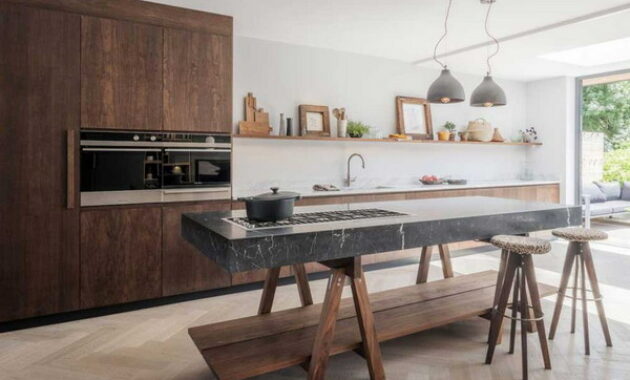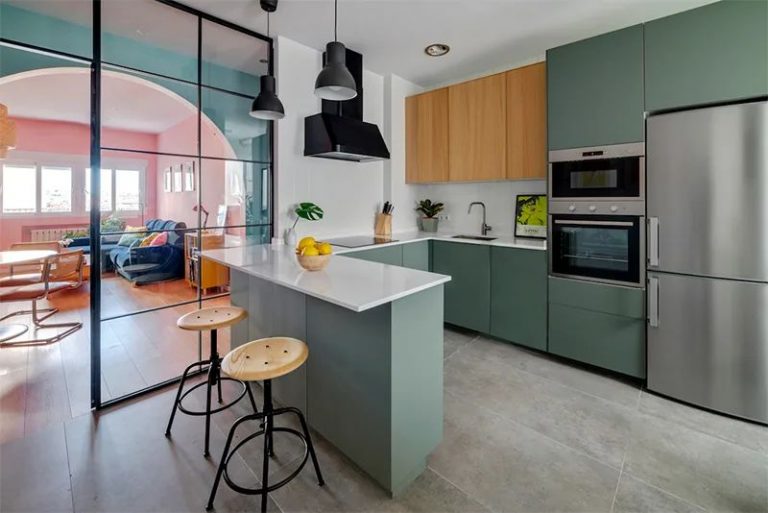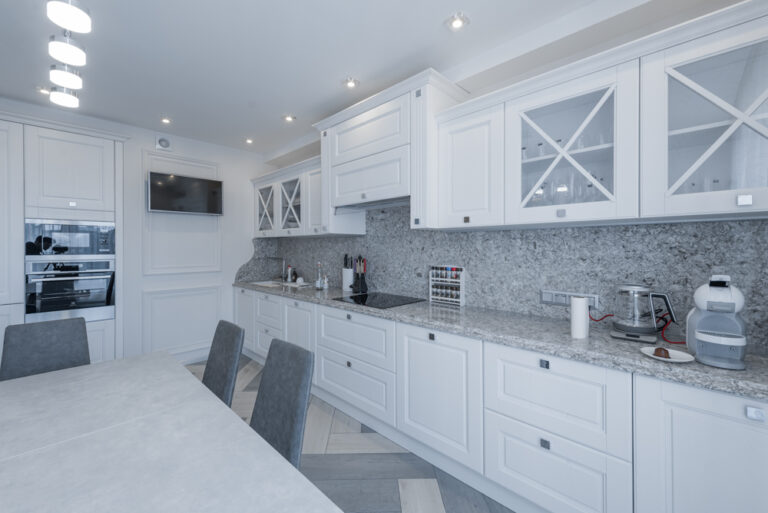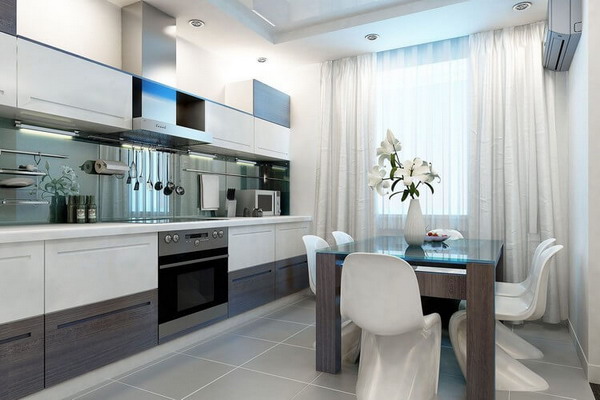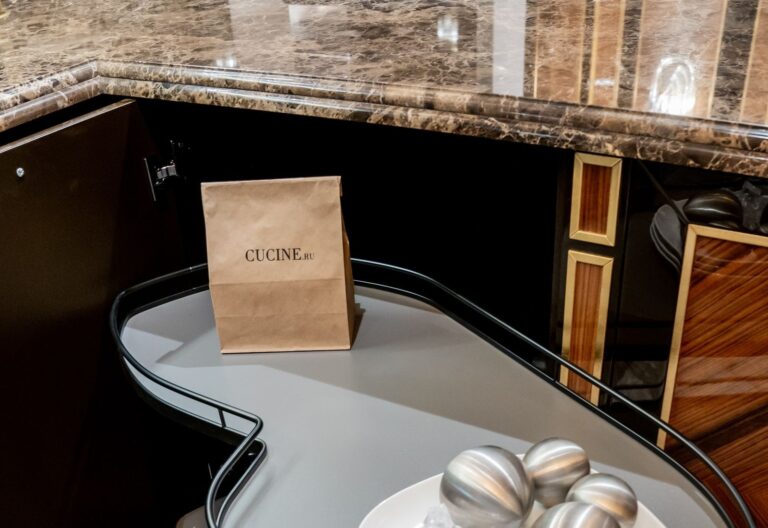Kitchen worktop materials: advantages and disadvantage
Choosing the kitchen worktop is not an easy one. After all, it doesn’t just have to look good, it also has to fulfill its purpose and be practical and robust. Choosing the right material is therefore crucial, both in terms of aesthetics and practicality. Solid wood, quartz, quartz composite or ceramic – however, the wide choice of countertop materials can be overwhelming. We will explain to you what you should pay attention to when choosing a kitchen worktop, introduce you to the most popular options and list all the advantages and disadvantages for each worktop material.
Contents
This is what matters when choosing the kitchen worktop
Choosing a countertop material in the kitchen influences both the daily cooking experience and the overall design of the room. In addition to good durability, visual aspects should not be ignored
- Design: Consider what design and color palette best suits your style and the decor of your kitchen. Each material has its own texture, color variation and appearance.
- Resistance: hot pots, sharp knives or moisture – the kitchen worktop is exposed to daily stress. Depending on how you use it, you should make sure that the work surface is more resistant to scratches, heat and stains.
- Care Requirements: Depending on the material, the kitchen countertop may have different care and maintenance requirements. For example, some surfaces need to be sealed or impregnated regularly. If you don’t want to think too much about care, an easy-care material is recommended.
- Cost: The choice of kitchen top material is always a question of cost. However, always compare the purchase costs with the longevity of the respective material – especially if you want to use the kitchen worktop for a long time.
- Installation: Would you like to build your kitchen yourself? Not all countertop materials are equally easy to install. Some, like concrete or granite, can be heavy and require special support structures or expertise to install.
Worktop material: advantages and disadvantages of natural stone, plastic, wood etc.
Laminate & Laminate
Laminate and laminate, such as HPL, are used as a decorative layer for simple pressboard panels. The production is relatively inexpensive, which is why the material can also be purchased as a kitchen countertop at a fairly low price. Laminate is available in different looks. For example, wood, granite or concrete can be imitated easily, realistically and cost-effectively. Due to the wide range of design options, worktops with laminate or laminate surfaces fit into both modern and traditional kitchens such as country house kitchens.
Possible damage: Scratches, burns and peeling of the surface are possible.
Laminate as a worktop: material advantages and disadvantages
Advantages
- Stain resistance: Good as long as the surface is not damaged.
- Moisture resistance: Good if the edges are properly sealed.
- Shock resistance: Good. Shocks are cushioned.
- Care Requirements: Easy to care for. Clean with mild detergent.
- Flexibility of dimensions: Very flexible. Can be cut to fit most shapes and sizes.
- Cost: Low to medium.
- Repair options: Minor damage can be repaired; larger ones may require plate replacement.
- Installation: Easy. Can be done independently.
Disadvantages
- Heat Sensitivity: Sensitive to hot pots and pans.
- Susceptibility to scratching: Medium.
Natural stone
Natural stone such as granite, marble, quartz or slate are still a very popular material for worktops and are often taken into account when planning kitchens due to their look and feel. Since the material is a natural product, each piece is unique and gives your dream kitchen a very individual touch. Depending on the stone you choose, different designs may be available. Regardless of whether the choice for the stone worktop ultimately falls on slate, granite or marble – natural stone is timeless and suits both classic and modern kitchens.
Possible damage: May break or tear if subjected to strong force.
Natural stone as a worktop: material advantages and disadvantages
Advantages
- Heat Sensitivity: Highly heat resistant.
- Susceptibility to scratches: Scratch resistant – especially granite.
- Flexibility of dimensions: Available in various thicknesses and can be cut to size.
Disadvantages
- Stain resistance: Depending on the stone: Granite is non-porous and therefore less sensitive to stains than marble.
- Moisture resistance: Must be impregnated to ensure moisture resistance.
- Care requirements: Regular impregnation and care with neutral cleaner or special stone cleaners necessary.
- Cost: Medium to high.
- Repair options: Cracks can be repaired professionally, but often remain visible.
- Installation: Requires expertise and special tools.
artificial stone
Artificial stone such as quartz composite is a popular alternative to real stone work surfaces. It looks very close to the natural version, but consists of ground, pressed and resin-bound natural stone and is therefore more resistant. There is a wide range of colors and patterns to choose from for artificial stone kitchen countertops. Although artificial stone works particularly well in modern kitchens, the neutral material has also proven itself in traditional kitchen styles.
Potential Damage: Resistant to most damage, but may crack in extreme temperatures.
Artificial stone as a worktop: material advantages and disadvantages
Advantages
- Stain resistance: Very high.
- Susceptibility to scratches: Very scratch-resistant.
- Moisture resistance: Non-porous and therefore very resistant to moisture.
- Care Requirements: Easy to care for. No sealing required.
- Flexibility of dimensions: Can be cut to many shapes and sizes.
Disadvantages
- Heat Sensitivity: Medium. Direct contact with hot objects should be avoided.
- Cost: Medium to high.
- Repair Options: Cracks can be difficult to repair.
- Installation: Installation requires specialist knowledge.
Ceramics
Ceramic countertops are made from natural clay that is shaped and then fired at high temperatures. They offer a hard and durable surface that is available in many different colors and designs. Ceramic plates convey a natural and warm aesthetic that fits into traditional, country and Mediterranean kitchen styles. However, modern processing methods also enable designs for contemporary and Scandinavian kitchens.
Possible damage: May break if strongly impacted by falling pots, etc.
Ceramic as a worktop: material advantages and disadvantages
Advantages
- Stain resistance: Very high.
- Heat sensitivity: Heat resistant.
- Susceptibility to scratches: scratch resistant.
- Moisture resistance: Water repellent.
- Care Requirements: Easy to care for. Clean with a damp cloth.
- Repair options: Individual broken tiles can be replaced.
Disadvantages
- Flexibility of dimensions: Restricted sizes due to the firing process.
- Cost: Mid to high price segment.
- Installation: Requires precise laying and can be time consuming.
Real wood
Wooden worktops, often made of solid wood such as oak, walnut or beech, not only offer a warm and natural aesthetic, but also a unique feel. Due to the individual grain, every work surface is unique. Real wood is ideal for traditional, rustic and Scandinavian kitchen designs. But it can also be used as a contrasting element in modern kitchens to enhance the room with warmth and naturalness. By choosing the type of wood, you decide on the color and look of the kitchen worktop.
Possible Damage: Susceptible to cuts, scratches and stains.
Real wood as a worktop: material advantages and disadvantages
Advantages
- Flexibility of dimensions: Highly flexible, can be easily cut and adjusted.
- Cost: Mid-price segment.
- Installation: Relatively easy, can be installed independently.
Disadvantages
- Stain resistance : May be susceptible to stains, especially on light woods.
- Heat Sensitivity: Not heat resistant. Trivets should be used for hot pots.
- Susceptibility to scratching: Can be scratched easily.
- Moisture resistance: Impregnation necessary for moisture resistance.
- Care requirements: High maintenance requirements. Must be oiled regularly and sanded occasionally.
- Repair options: Scratches and small damage can be sanded out.
stainless steel
Stainless steel worktops are common in professional kitchens, but also find their place in private kitchens. They offer a shiny, modern aesthetic and are hygienic. Stainless steel finishes are available in glossy or matte and are ideal for industrial, minimalist and modern kitchen styles.
Possible damage: Scratches and dents are possible.
Stainless steel as a worktop: material advantages and disadvantages
Advantages
- Stain Resistance: High, but can get water stains.
- Heat sensitivity: Heat resistant.
- Susceptibility to scratching: Can scratch, but develops a patina over time.
- Moisture resistance: Water repellent. Liquids cannot harm the surface.
- Flexibility of dimensions: Can be made to measure.
Disadvantages
- Care requirements: Cleaning with a special stainless steel cleaner is necessary.
- Cost: Upper price segment.
- Repair options: Small scratches can be polished. Larger dents are difficult to repair.
- Installation: Requires expertise.
Concrete
Concrete countertops convey a raw, unadulterated charm that is particularly popular in modern and industrial-style kitchens. The rough texture and matte finish of concrete can look both rustic and contemporary. However, concrete can also be colored and treated in such a way that the material can also be used in elegant designs. As with natural materials, when using concrete, each slab is unique and can be given individual colors and textures. Concrete countertops can be made directly at home or previously in a workshop.
Possible Damage: May develop cracks over time.
Concrete as a worktop: material advantages and disadvantages
Advantages
- Heat sensitivity: Heat resistant.
- Flexibility of dimensions: Highly flexible. Can be cast on site into any desired shape.
Disadvantages
- Stain Resistance: Must be sealed to prevent stains and contamination.
- Susceptibility to scratching: Can scratch.
- Moisture Resistance: Must be sealed to ensure moisture resistance
- Care requirements: High maintenance requirements. Regular sealing and use of special cleaners are necessary.
- Cost: Mid to high price segment.
- Repair options: Cracks can be filled, but often remain visible.
- Installation: Difficult. Requires specialist knowledge and special tools.
Solid surface materials (Corian)
Solid surface materials like Corian are made from a blend of acrylic resin and natural minerals and are known for their smooth, seamless surfaces and ability. This means that Corian panels are considered particularly hygienic. They are made in almost every color and pattern, offering a contemporary aesthetic that fits modern, Scandinavian and minimalist kitchen styles. Solid surface materials can be combined with other materials to create a unique design.
Possible Damage: Sensitive to heat and sharp objects.
Solid surface material as a worktop: material advantages and disadvantages
Advantages
- Stain resistance: Very high.
- Moisture resistance: Water repellent. Liquids cannot harm the surface.
- Care Requirements: Easy to care for. Clean with a damp cloth.
- Flexibility of dimensions: Highly flexible, seamless installation possible.
- Cost: Mid-price segment.
- Repair options: Scratches and small damage can be sanded out.
Disadvantages
- Heat Sensitivity: Not heat resistant.
- Susceptibility to scratches: Can be scratched, but can be repaired.
- Installation: Requires specialist knowledge.
Glas
Glass worktops are an eye-catcher in every kitchen. Their transparent or tinted designs can reflect light and brighten the room. They convey a feeling of lightness and modernity and fit into ultra-modern to contemporary kitchens. Depending on the look you want, transparent, tinted or frosted glass can be used.
Possible Damage: May break if strongly impacted by objects.
Glass as a worktop: material advantages and disadvantages
Advantages
- Stain resistance: Very high.
- Heat sensitivity: Heat resistant.
- Susceptibility to scratches: High scratch resistance.
- Moisture resistance: Water repellent.
- Care Requirements: Easy cleaning with glass cleaner.
Disadvantages
- Flexibility of Dimensions: Can be custom made but with some limitations.
- Cost: Upper price segment.
- Repair options: If the glass breaks, it must be replaced.
- Installation: Requires expertise.
Dekton
Dekton is an ultra-compact surface material made from a mixture of glass, porcelain and quartz. It is known for its robustness and variety of designs ranging from stone to abstract patterns. Dekton can fit into both traditional and modern kitchen styles depending on the color and pattern. With its smooth surface and variety of designs, it can form the central focus of a kitchen or blend seamlessly into the overall look.
Dekton as a worktop: material advantages and disadvantages
Advantages
- Stain resistance: Very high.
- Heat Sensitivity: Extremely heat resistant.
- Susceptibility to scratches: High scratch resistance.
- Moisture resistance: Water repellent.
- Care Requirements: Easy to clean.
- Flexibility of dimensions: Can be cut to size.
- Potential Damage: Highly resistant to most damage.
Disadvantages
- Cost: Upper price segment.
- Repair options: If the damage is severe, a replacement is required.
- Installation: Expertise required.
MDF (Medium Density Fiberboard)
MDF is a bonded wood product that provides a cost-effective alternative to natural wood. It is often finished with a laminate finish to achieve different looks, from imitation wood to high-gloss colors. It can be used in both traditional and modern kitchens. Especially when the budget for the kitchen worktop is low, it is often used without compromising on style.
Possible damage: May swell or warp if there is too much moisture.
MDF as a worktop: material advantages and disadvantages
Advantages
- Flexibility of dimensions: Highly flexible.
- Stain resistance: When sealed, resistant to dirt.
- Care Requirements: Regular cleaning with a damp cloth.
- Cost: Low price segment.
- Installation: Easy to install, often possible independently.
Disadvantages
- Heat Sensitivity: Not heat resistant.
- Susceptibility to scratching: Can scratch.
- Moisture Resistance: Susceptible to water penetration if not sealed properly.
- Repair options: Often difficult to repair, replacement may be necessary.
Conclusion: Worktop material: advantages and disadvantages in the kitchen
Choosing the right countertop material depends on your personal preferences, budget, and desired level of maintenance. Whether elegant natural stone such as quartz or marble, robust imitation stone such as quartz composite or high-quality solid wood – it is important to know the material advantages and disadvantages when choosing a worktop. Pay attention to the scratch resistance of the materials. Is the kitchen worktop easy to clean or do I need special cleaning products? Is it resistant to liquids and stains or does special care need to be taken? We know the advantages and disadvantages of all worktop materials, from classic stone worktops to solid wood panels, glass worktops and Dekton. We would be happy to support you with kitchen planning and provide you with detailed advice on creating your dream kitchen.
